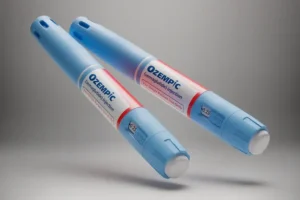Introduction: Tirzepatide Once Weekly for the Treatment of Obesity
Obesity remains one of the most pressing public health challenges worldwide, contributing to serious complications such as diabetes, cardiovascular disease, and premature mortality. Traditional approaches—diet, exercise, and behavior modification—often fall short of delivering sustained results. Pharmacological interventions are gaining momentum, particularly those demonstrating durable, clinically significant weight loss with manageable side effects.
The study titled “Tirzepatide Once Weekly for the Treatment of Obesity” by Jastreboff et al., published in the New England Journal of Medicine in 2022, evaluates a novel medication, tirzepatide, in a long-term clinical setting. The findings from the SURMOUNT-1 trial open a promising new chapter in weight loss treatment through a once-weekly injectable medication.
Background: The Burden of Obesity and Need for Effective Therapies
 More than 650 million adults globally are affected by obesity. The condition not only impacts quality of life but also imposes enormous economic and healthcare burdens. Until recently, few medications offered clinically meaningful weight loss without significant safety concerns.
More than 650 million adults globally are affected by obesity. The condition not only impacts quality of life but also imposes enormous economic and healthcare burdens. Until recently, few medications offered clinically meaningful weight loss without significant safety concerns.
Tirzepatide, a dual glucose-dependent insulinotropic polypeptide (GIP) and glucagon-like peptide-1 (GLP-1) receptor agonist, shows promise not only in glycemic control for type 2 diabetes but also in inducing substantial weight reduction. The SURMOUNT-1 trial aimed to examine tirzepatide’s efficacy and safety in individuals with obesity but without diabetes.
Study Design: A Robust, 72-Week Randomized Controlled Trial
The trial enrolled 2539 overweight or obese adults, with participants randomized across three double-blind arms to receive weekly subcutaneous tirzepatide at doses of 5 mg, 10 mg, or 15 mg, or placebo, for 72 weeks. The study population had a mean body weight of 104.8 kg and a BMI of 38.0, with 94.5% classified as obese (BMI ≥30).
Primary outcomes included:
- Mean percentage change in body weight from baseline to week 72
- Proportion of participants achieving ≥5%, ≥10%, and ≥20% weight reduction
- Evaluation of adverse events and cardiometabolic biomarkers
Results: Substantial and Sustained Weight Loss
 All three doses of tirzepatide yielded statistically significant and clinically impressive weight loss compared to placebo:
All three doses of tirzepatide yielded statistically significant and clinically impressive weight loss compared to placebo:
- 5 mg: -15.0% body weight reduction (95% CI, -15.9 to -14.2)
- 10 mg: -19.5% (95% CI, -20.4 to -18.5)
- 15 mg: -20.9% (95% CI, -21.8 to -19.9)
- Placebo: -3.1% (95% CI, -4.3 to -1.9)
The proportion of participants achieving key weight-loss milestones:
- ≥5% weight reduction: 85% (5 mg), 89% (10 mg), 91% (15 mg), vs. 35% (placebo)
- ≥20% weight reduction: 50% (10 mg), 57% (15 mg), vs. 3% (placebo)
These results firmly establish tirzepatide as one of the most effective anti-obesity medications currently under investigation.
Cardiometabolic Benefits
Beyond weight loss, tirzepatide also improved key cardiometabolic parameters, although the details of these improvements were not expanded upon in the primary publication. Nevertheless, the findings suggest a dual benefit for patients at risk for metabolic syndrome, hypertension, and cardiovascular disease.
Safety and Tolerability
As with many GLP-1 receptor agonists, gastrointestinal symptoms were the most common side effects, including nausea, diarrhea, and vomiting. These were mostly mild to moderate and occurred primarily during dose escalation.
Rates of treatment discontinuation due to adverse events:
- 5 mg: 4.3%
- 10 mg: 7.1%
- 15 mg: 6.2%
- Placebo: 2.6%
Importantly, no new safety signals were observed, and tirzepatide was considered well tolerated overall.
Implications: A Game-Changer in Weight Management?

The SURMOUNT-1 trial positions tirzepatide as a potentially game-changing therapy for obesity management. Unlike earlier medications that provided modest results or had significant side effects, tirzepatide offers:
- High efficacy across all measured doses
- Consistent safety and tolerability
- Improvements in cardiometabolic health
Given these outcomes, tirzepatide could dramatically shift clinical practice for managing obesity—especially in individuals who have failed traditional interventions.
Limitations and Next Steps
Though compelling, the study was limited by:
- Short duration beyond 72 weeks—long-term sustainability of weight loss remains unknown
- Lack of detailed reporting on cardiometabolic changes
- Exclusion of individuals with type 2 diabetes, despite the drug’s dual relevance
Future research should focus on:
- Long-term follow-up data
- Real-world effectiveness
- Combined strategies including behavioral counseling
Conclusion: A Transformative Step in Obesity Pharmacotherapy
The 2022 SURMOUNT-1 trial demonstrated that once-weekly tirzepatide can lead to remarkable and sustained weight loss over 72 weeks. With tolerable side effects and wide-ranging benefits, this medication could significantly enhance how clinicians approach obesity treatment.
While long-term studies are warranted, tirzepatide already stands as one of the most promising pharmacological tools for combatting the global obesity epidemic.
References
- Jastreboff AM, Aronne LJ, Ahmad NN, Wharton S, Connery L, Alves B, et al. Tirzepatide Once Weekly for the Treatment of Obesity. N Engl J Med. 2022;387(3):205–16.
- Wilding JPH, Batterham RL, Calanna S, et al. Once-Weekly Semaglutide in Adults with Overweight or Obesity. N Engl J Med. 2021;384(11):989–1002.
- Heymsfield SB, Wadden TA. Mechanisms, Pathophysiology, and Management of Obesity. N Engl J Med. 2017;376(3):254–66.
- Kushner RF, Calhoun DA, Rock CL. Approaching Obesity Management as a Chronic Disease. J Clin Endocrinol Metab. 2020;105(9):dgaa399.
- Gadde KM, Apolzan JW, Berthoud HR, et al. Mind Versus Metabolism: A Case for Heterogeneity of Obesity. Obesity. 2018;26(1):31–8.




